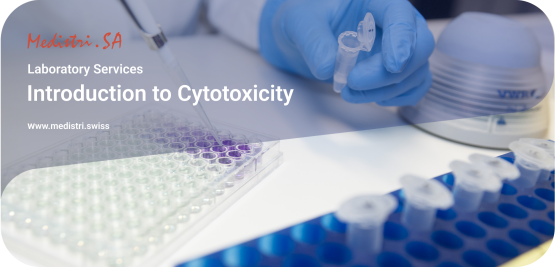(Download: Introduction to Cytotoxicity in PDF by Medistri)
Measuring the potential adverse effects of substances on living organisms is important to multiple industries. A property of the substance that needs to be known is its cytotoxic effect - whilst toxicity is a more general term for how harmful a substance is to living organisms, Cytotoxicity is a term that describes how toxic a substance is to cells :
👉 Toxicological Risk Assessment - ISO 10993-17: Alongside an analytical chemical characterization study, certain regulatory bodies require a toxicological assessment of extractables and leachables, for certain products, to establish the device’s safety limits of these impurities. ISO 10993-17:2002 specifies the determination of allowable limits for substances leachable from medical devices. It is intended for use in deriving standards and estimating appropriate limits where standards do not exist. It describes a systematic process through which identified risks arising from toxicologically hazardous substances present in medical devices can be quantified.
👉 Cytotoxicity - ISO 10993-5: Cytotoxicity tests are conducted to evaluate the general toxicity level of the medical device or material on cell culture through in vitro elution and agarose overlay methods. ISO 10993-5:2009 describes test methods to assess the in vitro cytotoxicity of medical devices.
These methods specify the incubation of cultured cells in contact with a device and/or extracts of a device either directly or through diffusion.
These methods are designed to determine the biological response of mammalian cells in vitro using appropriate biological parameters.
✔ Cytotoxicity is the most common test category utilized in ensuring the safety of medical devices. Used as an important screening tool as well as a significant biological endpoint for submission requirements, these tests assess the cytotoxic potential of a device or material to inhibit cell growth or cause cell death.
Cytotoxicity Testing is useful to observe the cell growth, reproduction and the morphological effects of the medical devices :
👉 Cytotoxic compounds can cause cell damage or cell death either through necrosis or apoptosis. Some substances are more cytotoxic than others, and manufacturers measure a chemical's cytotoxicity to make sure it's not harmful and/or fatal to patients, determining the toxicity of medical devices and their materials by exposing them to tissue cells in vitro and observing the effects.
Cytotoxicity Testing fall into two groups:
👉 Qualitative method
There are three types of qualitative tests, the results of which are determined by using a microscope to look for signs of cytotoxicity, such as changes in the size or configuration of cells or inhibited growth. These are judged on a scale of 0–4, with a score of 0 indicating no reactivity to the test material and a score of 4 indicating severe reactivity.
The three qualitative tests are as follows:
Elution: The most popular qualitative testing method, elution is also known as testing by extraction. During the test, a fluid extract of the test material is placed in contact with the cultured cells, which are then incubated for three days and evaluated for any signs of cytotoxicity.
Indirect Contact: Also known as the Agar Diffusion method, this test places a layer of agar between the material being tested and the cultured cells. The layer protects the cells from the physical effects of contact with the material being tested, but allows extractables from the material to pass through to the cell cultures.
Direct Contact: During the direct contact method, the test material is placed in direct contact with the cultured cells. This method is generally used for low-density materials like contact lenses.
👉 Quantitative method
The quantitative method is known as the MTT Assay. The MTT method is a colorimetric assay, and it can be performed using either extracts or direct contact. This test is graded based on the percentage of cells that are inhibited or die after contact with the test material.
Generally, the tests are performed in vitro on cultured mammalian cells, such as those of mice. The human body has a number of measures in place to protect cells from cytotoxins and pH imbalances, so by performing the tests on cells existing in vitro—without these defense systems—labs ensure a high degree of sensitivity in the tests.
Ultimately, the type of device and the materials you use will determine which cytotoxicity testing methods you should use. However, international regulatory bodies offer guidance on cytotoxicity testing for medical device manufacturers, which brings us to our final section about the regulatory side of this topic.
Required for all types of medical devices, cytotoxicity testing is a key element of the international standards. The international standards compiled as ISO 10993, and the FDA blue book memorandum (#G95-1) that is based on 10993-1, address the critical issue of ensuring device biocompatibility by identifying several types of tests for use in selecting device materials. Required for all types of devices, cellular toxicity testing is covered in 10993-5: "Tests for Cytotoxicity—In Vitro Methods."
Medistri’s in-house laboratory possesses an in-depth comprehension of the Cytotoxicity execution process to meet your regulatory requirements.
🎯 To learn more about Medistri’s Cytotoxicity services, visit on our website at www.medistri.swiss or directly contact our team at contact@medistri.swiss.
- The Medistri Team
#Medistri
